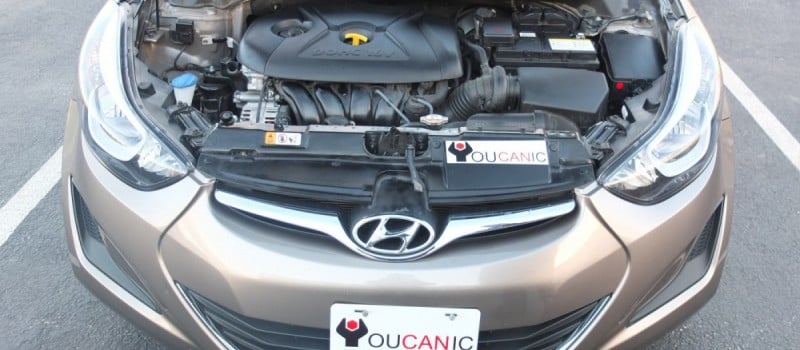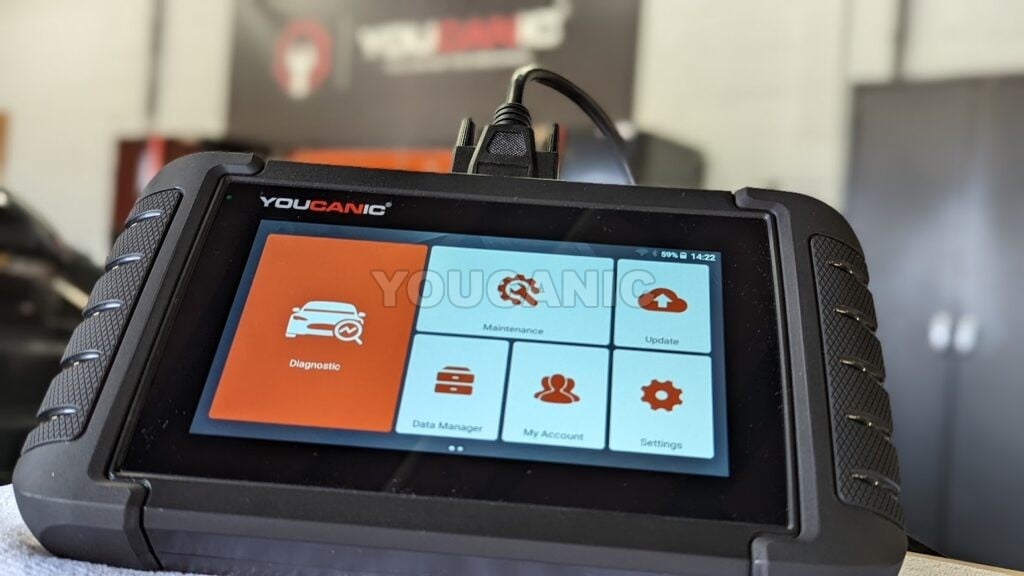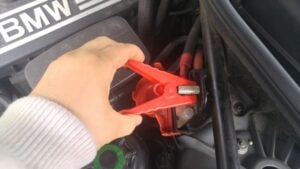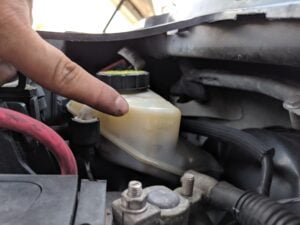Hyundai Kia Airbag Light Staying On: Meaning, Causes, & Troubleshooting
Does the airbag light on your Hyundai stay on? Learn why the Hyundai airbag light stays on, how to perform an airbag light reset, and common causes that can trigger the Hyundai airbag light.
What does Hyundai Airbag Light Mean?

A common problem Hyundai owners experience is the airbag light staying on constantly. If your Hyundai airbag light stays on when driving, it means a problem with the airbag system or a sensor has failed. The airbags in your car may not deploy in case of an accident.

Under normal operation, your instrument cluster’s airbag light will turn on for about five seconds when you turn on the ignition. The Airbag System does a quick self-check of all the sensors and components. If no problems are found, the airbag light on your Hyundai should turn off. If there are any component problems, the light stays on.
Before troubleshooting the airbag light on your Hyundai, we recommend that you verify with your Hyundai dealer to check if your vehicle is still under warranty. Your dealer should repair your car for free if your Hyundai is still under warranty.
How to Diagnose & Reset Hyundai Airbag Light

For this procedure, you will need a full system diagnostic scanner for Hyundai vehicles.
- Never measure the circuit resistance of an airbag component, even with a digital multimeter. If the circuit resistance is measured with a tester, airbag deployment can result in serious personal injury.
- When working on the airbag system, always disconnect the negative battery terminal first and wait for at least ten minutes before starting work.
The YOUCANIC Full System Scanner can read and clear all fault codes on every control module of your vehicle, including the Airbag SRS System. This scanner supports all vehicle make and models. This section explains how to read, erase, or clear Hyundai airbag lights using a Hyundai Airbag Scanner. Generic OBD2 scanners can not read airbag fault codes.
Airbag system fault codes are stored in the Airbag Module (SRS Control Unit) to provide accurate information describing why the airbag light is on.
- Locate the OBD-II port under the dashboard.

- Plug the scanner that can read airbag fault codes on a Hyundai.
- Turn the ignition to position II. All the dashboard lights turn on, but don’t start your Hyundai. The airbag light comes on and stays on as well.
- Select the Hyundai, then select the model (Elantra, Tucson, Accent, Santa Fe, Sonata, Genesis, Azera, Veloster, Equus, etc.)
- Select airbag / SRS in the menu.
- Select Read Codes. The scanner will communicate with the airbag control module and retrieve the fault codes. You may get a code such as B1620 – Airbag unit internal failure.
- If all the codes are stored, return and select Clear Codes. Follow on-screen prompts to clear the airbag fault codes from your Hyundai control unit.
Note that specific codes cannot be erased if you haven’t fixed the problem that triggered the airbag light in the first place. In other words, if an internal fault code is active or a crash is recorded, you won’t be able to turn off the airbag light until you address these problems.
You will need an OBD II diagnostic scanner to retrieve airbag codes and read and clear the airbag light on your Hyundai. Many Hyundai owners try to turn off the airbag light using a generic OBD-II code reader, but such scanners can’t reset the light.
Common Problems
Low Battery Voltage
The airbag light may have turned on after you jump-start your Hyundai. The discharged car battery typically causes this, not providing the airbag module’s necessary voltage to function correctly. If the battery voltage drops below 9 volts, your Hyundai airbag light will stay on until you clear the codes.
When you scan the airbag module, you will get a fault code stating that the control unit was detected under voltage. Replace your old battery (or fix any alternator problems). Otherwise, the airbag warning light will turn back on.
Seat Belt Buckle Defective

The seat belt buckle sensor wears out in specific Hyundai models, eventually triggering the airbag warning light. The microswitch inside the seat belt buckle wears out over time and eventually fails to function correctly. Replacing the buckle is the least expensive way to fix this problem.
Side Impact Sensor

In some cases, side-impact airbag sensors can be the culprit. The sensor is installed in the B-pillar or door panel. If it fails, it will need to be replaced. Check the resistance of the side impact sensor.

It should be between 1.7 and 2.3 ohms. Once the sensor is replaced, clear the fault codes, as described in this article. The side impact sensor is mounted on the door panel.
Airbag module high resistance

The airbag light may develop a high resistance code due to a damaged wire harness or clockspring. Do not use a multimeter to test airbag components because the multimeter may deploy the airbag, leading to injuries.
Passenger Seat Sensor / Occupancy Sensor

Under the bottom cushion of your Hyundai’s passenger seat, you will find a weight sensor. Hyundai calls this the Weight Classification System (WCS), and its primary purpose is to detect if a light person or child is sitting in the front passenger seat. These sensors fail over time and often trigger the airbag light to illuminate your Hyundai dashboard.
If the fault code (also called Diagnostic Trouble Code -DTC) points to the passenger seat’s weight sensor, check the wires under the seat first. The electrical connector for the seat occupancy sensor often gets disconnected due to frequent seat movement. The weight sensors must sometimes be replaced to fix this specific Hyundai airbag light problem.
All Hyundai vehicles, including Accent, Sonata, Santa Fe, Elantra, Genesis, and Azera, are equipped with a Supplemental Restraint System (SRS), often called the airbag system in the vehicle. The Airbag System has many components, including the SRS control module, retractors, retractor pre-tensioner assembly, crash and impact sensors, etc.
Additional Information
Why is my Hyundai Airbag Warning Light On?
The airbag module continuously monitors all the components that make up the airbag system. If the SRS module detects a sensor failure or high resistance to any sensors while the vehicle power supply is on, the system stores a fault code in the SRS Control Unit. Once the airbag module detects a fault, it will warn the driver by illuminating the SRS / Airbag warning light on the instrument cluster. That’s how you, the driver know there is a problem with your airbag system. As described in this article, these codes can be retrieved and cleared with the Hyundai GDS scanner or an advanced OBD2 scanner.

Check the fuses under the dash if the airbag light never comes on. You will see a 15A fuse dedicated to the Airbag or A/Bag in the fuse box. Inspect this fuse and replace it if necessary.
Why is my Hyundai Airbag Light Flashing?
If the airbag light on your Hyundai is flashing, that is because the airbag module (SRSCM – SRS Control module1) is either defective, isn’t programmed correctly, or has been replaced but not programmed. When you install a new Hyundai airbag module, you need to perform variant coding. You will need to take your Hyundai to the dealer or a specialized auto repair shop that can complete variant coding on your airbag module.
Show Airbag Fault Codes
You will get one of the following codes when you scan your Hyundai for fault codes.
B1102 Battery Voltage Low
B1326 FIS Front Impact Sensor Driver Short to Ground
B1327 FIS Front Impact Sensor Driver Short to Battery
B1328 FIS Front Impact Sensor Driver Defect
B1101 Battery Voltage High
B1329 FIS Front Impact Sensor Driver Communication error
B1333 FIS Front Impact Sensor Passenger Defect
B1334 FIS Front Impact Sensor Passenger Communication error
B1335 FIS Front Impact Sensor Passenger Wrong ID
B1330 FIS Front Impact Sensor Driver Wrong ID
B1331 FIS Front Impact Sensor Passenger Short to Ground
B1332 FIS Front Impact Sensor Passenger Short to Battery
B1341 Remote Crash Sensors Cross-Coupling
B1346 Driver Airbag Resistance too High (1st stage)
B1347 Driver Airbag Resistance too Low (1st stage)
B1348 Driver Airbag resistance circuit short to Ground (1st stage)
B1349 Driver Airbag resistance circuit short to Battery (1st stage)
B1352 Passenger Airbag Resistance too High (1st Stage)
B1353 Passenger Airbag Resistance too Low (1st stage)
B1354 Passenger Airbag Resistance Circuit Short to Ground (1st Stage)
B1355 Passenger Airbag Resistance Circuit Short to Battery (1st Stage)
B1361 Pre-tensioner Front-Driver Resistance to High
B1362 Pre-tensioner Front-Driver Resistance too Low
B1363 Pre-tensioner front-Driver resistance circuit short to Ground
B1364 Pre-tensioner front-Driver resistance circuit short to Battery
B1367 Pre-tensioner Front-Passenger Resistance to High
B1368 Pre-tensioner Front-Passenger Resistance too Low
B1369 Pre-tensioner Front-Passenger Resistance Circuit Short to Ground
B1370 Pre-tensioner Front-Passenger Resistance Circuit Short to Battery
B1378 Side Airbag Front-Driver Resistance too High
B1379 Side Airbag Front-Driver Resistance too Low
B1380 Side Airbag Front-Driver Resistance Circuit Short to Ground
B1381 Side Airbag Front-Driver Resistance Circuit Short to Battery
B1382 Side Airbag Front-Passenger Resistance too High
B1383 Side Airbag Front-Passenger Resistance too Low
B1384 Side Airbag Front-Passenger Resistance Circuit Short to Ground
B1385 Side Airbag Front-Passenger Resistance Circuit Short to Battery
B1395 Firing Loops Interconnection Fault
B1400 SIS-Side Impact Sensor Front-Driver defect
B1401 SIS Side Impact Sensor Front-Driver Circuit Short to Ground
B1402 SIS Side Impact Sensor Front-Driver Circuit Short to Battery
B1403 SIS Side Impact Sensor Front-Passenger Defect
B1404 SIS Side Impact Sensor Front-Passenger Circuit Short to Ground
B1405 SIS Side Impact Sensor Front-Passenger Circuit Short to Battery
B1409 SIS-Side Impact Sensor Front-Driver Communication Error
B1410 SIS-Side Impact Sensor Front-Passenger Communication Error
B1414 SIS Side Impact Sensor Front-Driver Wrong ID
B1415 SIS-Side Impact Sensor Front-Passenger Wrong ID
B1473 Inflatable Curtain Airbag Front-Driver Resistance to High
B1474 Inflatable Curtain Airbag Front-Driver Resistance too Low
B1475 Inflatable Curtain Airbag Front-Driver Resistance Circuit Short to Ground
B1476 Inflatable Curtain Airbag Front-Driver Resistance Circuit Short to Battery
B1477 Inflatable Curtain Airbag Front-Passenger Resistance to High
B1478 Inflatable Curtain Airbag Front-Passenger Resistance too Low
B1479 Inflatable Curtain Airbag Front-Passenger Resistance Circuit Short to Ground
B1480 Inflatable Curtain Airbag Front-Passenger Resistance Circuit Short to Battery
B1481 Driver Airbag Resistance too High(2nd stage)
B1482 Driver Airbag Resistance too Low(2nd stage)
B1483 Driver Airbag Resistance Circuit Short to Ground(2nd stage)
B1484 Driver Airbag Resistance Circuit Short to Battery(2nd stage)
B1485 Passenger Airbag Resistance too High(2nd stage)
B1486 Passenger Airbag Resistance too Low(2nd stage)
B1487 Passenger Airbag Resistance Circuit Short to Ground(2nd stage)
B1488 Passenger Airbag Resistance Circuit Short to Battery(2nd stage)
B1489 PODS(Passenger Occupant Detecting System) ECU Defect
B1490 PODS(Passenger Occupant Detecting System) Sensor(Bladder) Defect
B1493 PODS(Passenger Occupant Detecting System) Communication error
B1494 PODS(Passenger Occupant Detecting System) Wrong ID
B1495 BTS(Belt-Tension Sensor) Defect
B1496 PODS(Passenger Occupant Detecting System)Not calibrated
B1511 Buckle Switch Driver open or short to Battery
B1512 Buckle Switch Driver short or short to Ground
B1513 Buckle Switch Passenger open or short to Battery
B1514 Buckle Switch Passenger short or short to Ground
B1515 Buckle Switch Driver Defect
B1516 Buckle Switch Passenger Defect
B1517 Buckle Switch Driver Instability
B1518 Buckle Switch Passenger instability
B1620 Internal fault-Replace SRSCM
B1650 Crash Recorded in 1st Stage Only(Frontal-Replace SRSCM)
B1651 Crash Recorded in Front-Driver Side Airbag(Replace SRSCM)
B1652 Crash Recorded in Front-Passenger Side Airbag(Replace SRSCM)
B1657 Crash Recorded in Belt Pre-tensioner only
B1658 Belt Pre-tensioner 6 times Deployment
B1670 Crash recorded in full stage(Frontal-Replace SRSCM)
B1683 Exceed Maximum Coding Number
B1684 ACU Configuration is different
B1738 P-SIS front – Driver Wrong ID
B1739 P-SIS Front-Driver Defect
B1740 P-SIS Front-Driver Short to Ground
B1741 P-SIS Front-Driver Short to Battery
B1742 P-SIS Front-Driver Communication Error
B1744 P-SIS front – Passenger Wrong ID
B1745 P-SIS Front-Passenger Defect
B1746 P-SIS Front-Passenger Short to Ground
B1747 P-SIS Front Passenger Short to Battery
B1748 P-SIS Front-Passenger Communication Error
B1762 ACU Coding Error
B2502 Passenger Airbag Telltale Lamp Failure
B2500 Warning lamp Failure
Hyundai Airbag Components and Location.Pre-tensioners, Show
For a diagram of the following components and their locations, click here and here.
- Driver Airbag (DAB) Module and Clock Spring
- Driver steering wheel
- Passenger Airbag (PAB) Module
- Side Airbag (SAB) Module
- In the front seat. The outer side of the seat.
- Curtain Airbag (CAB) Module
- Supplemental restraint system (SRS)
- SRSCM (SRS Control Module)3
- Under the center console. Behind the cigarette outlet.
- Seat Belt Pre-tensioners (BPT)

- Anchor Pre-tensioner (APT)

- Front Impact Sensor (FIS)
- By the headlights. Left and right.
- Pressure Side Impact Sensor (PSIS)
- Side Impact Sensor (SIS)
- Either on the door panel or B-pillar.
- Seat Track Position Sensor (STPS)
- Weight Classification System (WCS)
How much does it cost to fix the airbag light on a Hyundai?
If you call your Hyundai dealer or your local auto repair shop, they will ask you to take the car in for airbag light diagnostics, ranging between $80 and $130. You can diagnose the Hyundai airbag light by following the instructions on this page.
The dealer does the same diagnostics. The dealer will connect their diagnostic scanner to the OBD-2 port and read the airbag module’s fault codes. After they read the fault codes, they have a better idea of what is wrong with your Hyundai and write you a quote on how much it will cost to fix the airbag light on your Hyundai.
It could be something as simple as the airbag light needing clearing (which you can reset if you have the right scanner), a defective clock spring, or a problem with the passenger seat weight sensor. Common Hyundai Airbag Light ON Causes. Always read the airbag fault codes before replacing any airbag system components.
We hope you find the Hyundai Airbag Light Stays On guide helpful. Check these troubleshooting and repair guides for more help on your Hyundai.










If the scan shows a code replace
SRSCM what then?